You’ve talked about your volunteering over the years. Do you have any hobbies?
Well, the writing I did for newsletters and Websites was also a hobby. I enjoyed doing it. Golf and bowling too. I know; I can talk about gardening.
Flower gardens?
That and vegetable gardening. And composting for them; I’ll get to that later.
Okay.
It would start each year around March. I’d get out in the yard as soon as it was warm enough and start turning over the soil.
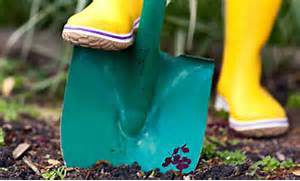
I devoted a plot of land in the backyard just for veggies. A rectangle 25 feet by 40 feet. Or 1,000 square feet. Later I added a bit to that. Plus I grew flowers in narrow beds against three sides of the house.
Where did you buy your plants?
Oh, I didn’t buy plants. I started everything from seed. That was half the fun. And some I started indoors.
How did you do that?
With a grow lamp.
What’s that?
It’s a lamp with fluorescent tubes and a platform below for the plants..
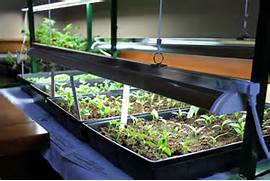
Some vegetables and flowers you can start outside, but others are better started inside. Under the lights.
You liked that?
Oh, yeah. First you plant the seed in an appropriate potting soil.
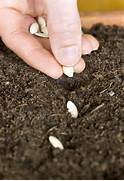
And then you wait — impatiently, of course — for the thrill of those first sprouts.
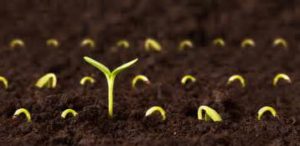
When the time is right, I would transplant them outside.
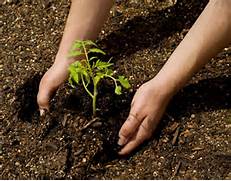
When the time is right. When is that?
For a tender plant like a tomato, it’s when the danger of frost is usually over. Around here that’s the middle of May.
So you start the seed when?
Counting backwards, if the seed packet says the seed germinates in, say, 6 weeks, that puts you back to the beginning of April. Allow a couple of weeks for it to get established inside and you’re talking about starting the seed the middle of March.
When you’re also outside digging the soil.
Right. It’s a busy time of the year.
And speaking of preparing the soil, let’s talk about compost.
Okay.
Compost is vegetable matter broken down into a form that serves as plant food. And it also creates a more workable soil. In a soil heavy in clay, for instance, it helps separate the clay particles.
How do you make it?
It starts with kitchen scraps. Left-over pieces of vegetables that you might normally throw in the garbage go into the compost instead.
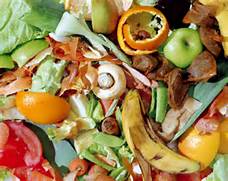
Just not animal materials like meat cuttings. Just veggies. An added bonus is that these scraps you compost aren’t going to waste in a landfill. That’s good for the environment.
I also saved the grass clippings I would get when I mowed the lawn.
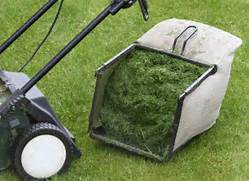
And I would build a compost pile in layers. A layer of grass. Then a layer of kitchen scraps. Add a little moisture so it won’t dry out. Then some more grass clippings. Like that.
I see.
But the pile needs air to help the vegetable matter break down. So after a layer of veggies I would lay across the pile three dowel sticks.
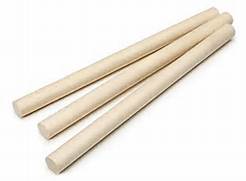
And after the pile had settled for a few days I would pull out the sticks and I would have three tunnels that air could get in to help the pile cook.
Cook?
Oh, yeah. When the vegetable matter started breaking down, the pile would get quite hot.
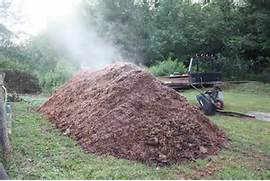
And when the process was complete, I would have a nice crumbly handful of lovely compost.
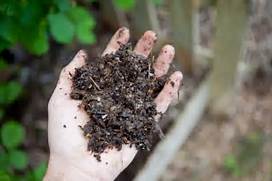
And I would spread that good stuff and work it into the soil to create a really fertile field.
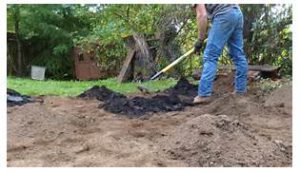
And over the summer we could enjoy freshly picked tomatoes, peppers, beans, broccoli. And each year I’d try something new, just to see if I could grow it. Like potatoes. Strawberries. Peanuts. Like that.
Nice.
One crop grew so well that I had more than I could use. Cherry tomatoes.
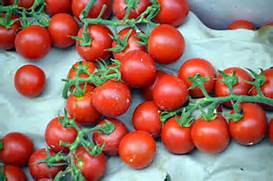
I would go out in the morning, fill a box with them, and take it to work. Set up a sign that invited my co-workers to take a few.
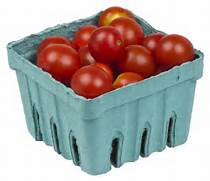
And they were appreciated. When I retired, one of our artists drew a cartoon of me and included in it a box of cherry tomatoes. I have the painting on my office wall.